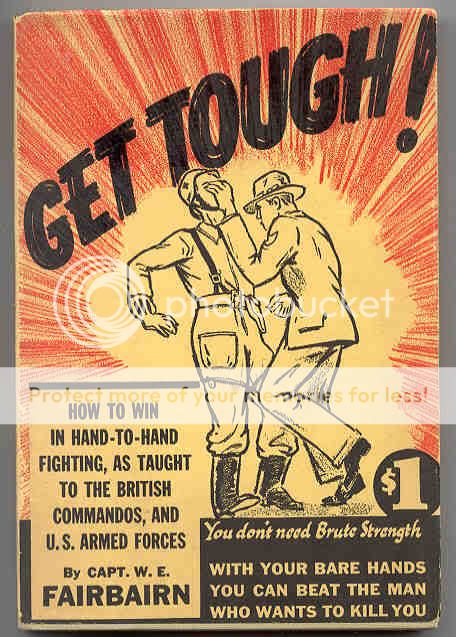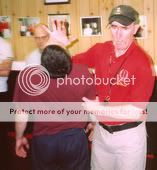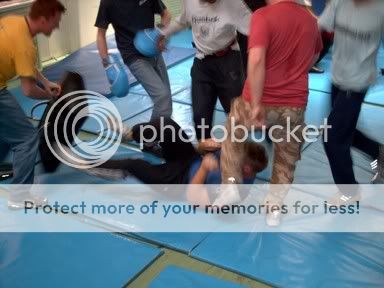Overview of Combatives
Page 1 of 1
 Overview of Combatives
Overview of Combatives
On this forum we talk a lot about “Combatives”, which is expected, since that is what I train in, and teach. It’s worth taking a minute to discuss exactly what we mean by Combatives is not a martial art, like Karate, Ju-jutsu, Aikido, Wing Chun. Nor is it a “style”, like Shotokan or Goju-ryu. In articles and forum threads we sometimes see people discussing the merits of a style or system and comparing Combatives, as if it was another similar activity. It’s not. Combatives could be described as “what works in a fight”, and as such transcends such comparative discussions; because if you use this definition the question then becomes “what do you think is best for self protection, Wing Chun, or what works in a fight?” Do you see what I mean, it becomes a ridiculous question.
So, how can we justify the claim that we are emphasising “what works in a fight”?

The primary instructors of Combatives teach from their own direct experience. When Fairbairn and Sykes were appointed as the staff for Britain’s wartime close-combat training it wasn’t because they had cups, trophies, or even because of the black-belt grades. It was because they had used their methods in countless violent confrontations, on the streets of Shanghai, the World’s most dangerous city. Experience was further gathered as trainees returned from wartime operations, so by 1945 the Shanghai foundation was laminated by even more direct application, making the methods taught by Fairbairn, Sykes and their associates highly tested under combat.

Since the war other instructors have offered the results of experience working in the frontline security industry.... notably Geoff Thompson and Peter Consterdine.
All the instructors mentioned teach from “what works in the street”. They all teach different techniques, because we are all individuals and have our own preferences, but the concepts they teach all have a commonality. Everything is simple, direct, aggressive. Pre-emptive where possible, counter-offensive where not. From this we can extend the definition of Combatives to “what works in the street for the
majority of people”
After a recent training session a few of us adjourned to Chinatown for an obligatory scoff. One of the guys mentioned he’d watched a video of a noted MMA instructor, who had disparaged Combatives by saying, in effect, it’s a lot of out of shape guys in cammo gear. Actually, that’s a fair one. Putting on cargo pants to teach does not make a Combatives teacher. Regarding fitness I remember being unimpressed by a lot of the guys who talked the talk in magazines...some of them looked like they couldn’t run up a flight of stairs without stopping five times.

Fitness is essential, to us it’s the mirror image to fighting. “Toughness” is being tough on yourself, pushing the limits, never giving up.... because the scum you confront are likely to be hyped on speed or coke, or in a drunken rage, or just working on sheer natural viciousness. You must have willpower as a weapon, and that is developed in arduous training. Anyway guys, that’s a few thoughts on what we mean by Combatives. Hope it makes sense to you, and puts a context to our discussions here.
................................
Personally, I have a lot of regard for the trad Martial arts.... they are a great pastime, and a lot of very good people immerse themselves in their study. Combatives, or training for self-protection is a different topic.
Why do some instructors complicate the subject? I remember talking to Nick Hughes and I suggested that it was possible to do away with ritual and condense the syllabus. He pointed out that ritual, philosophy, grading, belts, titles was exactly what attracted most students and kept them on the ladder.
Essentially it's a financial consideration. You'll never get rich teaching the realistic stuff. Although because WW-2 Combatives is gaining a higher profile I'm expecting a lot of bandwagon jumping, with guys who were wearing robes and calling themselves the Soke of Boohoo-ryu last week, recycling into combat cammos and announcing they are the heirs to the Fairbairn system.
Sport competition is the antithesis to Combatives, despite the US Army currently teaching BJJ as their hand-to-hand system. They would be better served with resurrecting the Pugil Stick training, or, better still, full Padded Suit training.

TOOLBOX
Remember those blockbuster action movies where the hero finally decides to take on the baddies and breaks into an armoury to equip himself for the fight. Anyone with the slightest knowledge of weapons was always amused to see the hero sling several weapons over his shoulders, many of which did exactly the same job. Instead of climbing over walls or trekking through the jungle with all these weapons it would have been better to select one long gun, together with sufficient spare mags, plus a backup pistol.
Of course this is entertainment, but do we similarly clutter ourselves with unnecessary “weapons” when we prepare ourselves for self protection?
Over the past couple of years we have discussed technique selection quite a bit. It is obviously of interest to our readers, and is an important topic. In this post I want to reinforce a couple of points.
INSTRUCTORS SYLLABUS
Combatives instructors must present the full curriculum of major pre-emptive strikes and effective counter-strikes. Ideally, of course, this curriculum will be based on their personal experience. Failing that, they should be first generation students of someone who has such experience.

PERSONAL SYLLABUS
As an individual you should train under an experienced instructor, then select strikes which best suit you. This is a completely subjective. We are all physically and emotionally different.
At the recent International I asked the guest instructors to present a different essential strike. [You can read the full program in the Seminar Review thread]. The idea of this was to offer a “buffet” of techniques from which the trainee could select a core to take away for future attention
Talking to Kjetil at the VIP Protection Program he made the point that very few techniques are desirable in the armoury. So, examine your syllabus and look at what you can retain and what you can discard.
THE CORE
Start with a major hand strike, it may be the Tiger’s Claw, it may be the Elbow, it may be one of several excellent strikes, that doesn’t matter; what does matter is that it suits you. You feel good doing it. It is natural for you.
Now analyse the strike. Is it a long-range strike, like the Tiger’s Claw/ In which case, you may want to add a close-range follow up.
Is it a close-range strike, like the Chinjab, in which case you may want to include something like a Slap to deal with that distance.
If you are a fan of the Hammerfist, you probably like the “cycling” action, so will want to work on the offhand action.
We all must work on transitioning to kneestrikes, using hookups or clamps to reinforce this.
So, you end up with a compact package consisting of a long-range hand strike, a close range hand strike, and the ability to shift target attention to the Lowline with kneestrikes. That’s a pretty decent little package to work on.
Can you add more? Sure, but when you remember you’ll be working on task-related fitness, weapons disarms, stress drills and scenario work, you don’t really need to expand the syllabus, just increase the intensity.
There is nothing wrong with training more strikes, but for the majority of readers with limited training time it may be wise to stick to that compact package.
Train hard, stay, on guard!
PROGRESSION
Another training point concerns the order of the program. A TMA program might be warm-up, Basics, Combinations, Kata, Sparring, warm down.
However, for Combatives you don't need to follow a regimented sequence every session.
You should always start with a warm up. Get your heartrate up, blood pounding before doing the impact training.
If you then go on to basic padwork [performing the individual strikes, working on body dynamics, non-telegraphing, shock power etc] then there is still an element of warm-up involved. Mentally you can still be transitioning into the training phase. Attention may not be 100% on the striking.
Now consider that you commence with an application drill instead, the 180 Reaction Drill, the Gauntlet, or some similar drill where you are really "in the mix" firing shots at all angles, fast moving, getting ragged all round the room. If you then go on to do basics the whole thing changes. The basics are then seen as an essential skill, which you have just been trying to apply under difficult circumstances. Basic drill then becomes your chance to hone the strikes and do better next time in the application drill. Motivation then goes up tremendously.
I hope this makes sense. The order you perform the syllabus components can affect the training benefit. Remember we are not training the strikes to perform the strikes in training. We are training the strikes to perform the strikes in the street. As such, all training should be reviewed and adapted to reflect this aim.
Cheers,
Den
So, how can we justify the claim that we are emphasising “what works in a fight”?

The primary instructors of Combatives teach from their own direct experience. When Fairbairn and Sykes were appointed as the staff for Britain’s wartime close-combat training it wasn’t because they had cups, trophies, or even because of the black-belt grades. It was because they had used their methods in countless violent confrontations, on the streets of Shanghai, the World’s most dangerous city. Experience was further gathered as trainees returned from wartime operations, so by 1945 the Shanghai foundation was laminated by even more direct application, making the methods taught by Fairbairn, Sykes and their associates highly tested under combat.

Since the war other instructors have offered the results of experience working in the frontline security industry.... notably Geoff Thompson and Peter Consterdine.
All the instructors mentioned teach from “what works in the street”. They all teach different techniques, because we are all individuals and have our own preferences, but the concepts they teach all have a commonality. Everything is simple, direct, aggressive. Pre-emptive where possible, counter-offensive where not. From this we can extend the definition of Combatives to “what works in the street for the
majority of people”
After a recent training session a few of us adjourned to Chinatown for an obligatory scoff. One of the guys mentioned he’d watched a video of a noted MMA instructor, who had disparaged Combatives by saying, in effect, it’s a lot of out of shape guys in cammo gear. Actually, that’s a fair one. Putting on cargo pants to teach does not make a Combatives teacher. Regarding fitness I remember being unimpressed by a lot of the guys who talked the talk in magazines...some of them looked like they couldn’t run up a flight of stairs without stopping five times.

Fitness is essential, to us it’s the mirror image to fighting. “Toughness” is being tough on yourself, pushing the limits, never giving up.... because the scum you confront are likely to be hyped on speed or coke, or in a drunken rage, or just working on sheer natural viciousness. You must have willpower as a weapon, and that is developed in arduous training. Anyway guys, that’s a few thoughts on what we mean by Combatives. Hope it makes sense to you, and puts a context to our discussions here.
................................
Personally, I have a lot of regard for the trad Martial arts.... they are a great pastime, and a lot of very good people immerse themselves in their study. Combatives, or training for self-protection is a different topic.
Why do some instructors complicate the subject? I remember talking to Nick Hughes and I suggested that it was possible to do away with ritual and condense the syllabus. He pointed out that ritual, philosophy, grading, belts, titles was exactly what attracted most students and kept them on the ladder.
Essentially it's a financial consideration. You'll never get rich teaching the realistic stuff. Although because WW-2 Combatives is gaining a higher profile I'm expecting a lot of bandwagon jumping, with guys who were wearing robes and calling themselves the Soke of Boohoo-ryu last week, recycling into combat cammos and announcing they are the heirs to the Fairbairn system.
Sport competition is the antithesis to Combatives, despite the US Army currently teaching BJJ as their hand-to-hand system. They would be better served with resurrecting the Pugil Stick training, or, better still, full Padded Suit training.

TOOLBOX
Remember those blockbuster action movies where the hero finally decides to take on the baddies and breaks into an armoury to equip himself for the fight. Anyone with the slightest knowledge of weapons was always amused to see the hero sling several weapons over his shoulders, many of which did exactly the same job. Instead of climbing over walls or trekking through the jungle with all these weapons it would have been better to select one long gun, together with sufficient spare mags, plus a backup pistol.
Of course this is entertainment, but do we similarly clutter ourselves with unnecessary “weapons” when we prepare ourselves for self protection?
Over the past couple of years we have discussed technique selection quite a bit. It is obviously of interest to our readers, and is an important topic. In this post I want to reinforce a couple of points.
INSTRUCTORS SYLLABUS
Combatives instructors must present the full curriculum of major pre-emptive strikes and effective counter-strikes. Ideally, of course, this curriculum will be based on their personal experience. Failing that, they should be first generation students of someone who has such experience.

PERSONAL SYLLABUS
As an individual you should train under an experienced instructor, then select strikes which best suit you. This is a completely subjective. We are all physically and emotionally different.
At the recent International I asked the guest instructors to present a different essential strike. [You can read the full program in the Seminar Review thread]. The idea of this was to offer a “buffet” of techniques from which the trainee could select a core to take away for future attention
Talking to Kjetil at the VIP Protection Program he made the point that very few techniques are desirable in the armoury. So, examine your syllabus and look at what you can retain and what you can discard.
THE CORE
Start with a major hand strike, it may be the Tiger’s Claw, it may be the Elbow, it may be one of several excellent strikes, that doesn’t matter; what does matter is that it suits you. You feel good doing it. It is natural for you.
Now analyse the strike. Is it a long-range strike, like the Tiger’s Claw/ In which case, you may want to add a close-range follow up.
Is it a close-range strike, like the Chinjab, in which case you may want to include something like a Slap to deal with that distance.
If you are a fan of the Hammerfist, you probably like the “cycling” action, so will want to work on the offhand action.
We all must work on transitioning to kneestrikes, using hookups or clamps to reinforce this.
So, you end up with a compact package consisting of a long-range hand strike, a close range hand strike, and the ability to shift target attention to the Lowline with kneestrikes. That’s a pretty decent little package to work on.
Can you add more? Sure, but when you remember you’ll be working on task-related fitness, weapons disarms, stress drills and scenario work, you don’t really need to expand the syllabus, just increase the intensity.
There is nothing wrong with training more strikes, but for the majority of readers with limited training time it may be wise to stick to that compact package.
Train hard, stay, on guard!
PROGRESSION
Another training point concerns the order of the program. A TMA program might be warm-up, Basics, Combinations, Kata, Sparring, warm down.
However, for Combatives you don't need to follow a regimented sequence every session.
You should always start with a warm up. Get your heartrate up, blood pounding before doing the impact training.
If you then go on to basic padwork [performing the individual strikes, working on body dynamics, non-telegraphing, shock power etc] then there is still an element of warm-up involved. Mentally you can still be transitioning into the training phase. Attention may not be 100% on the striking.
Now consider that you commence with an application drill instead, the 180 Reaction Drill, the Gauntlet, or some similar drill where you are really "in the mix" firing shots at all angles, fast moving, getting ragged all round the room. If you then go on to do basics the whole thing changes. The basics are then seen as an essential skill, which you have just been trying to apply under difficult circumstances. Basic drill then becomes your chance to hone the strikes and do better next time in the application drill. Motivation then goes up tremendously.
I hope this makes sense. The order you perform the syllabus components can affect the training benefit. Remember we are not training the strikes to perform the strikes in training. We are training the strikes to perform the strikes in the street. As such, all training should be reviewed and adapted to reflect this aim.
Cheers,
Den
Dennis M- Guest
 Re: Overview of Combatives
Re: Overview of Combatives
I've updated the OVERVIEW OF COMBATIVES series, which I wrote in my old Reality Check Column.
Although the first part is above, I thought the guys might want to read the full four-part series, so you can find them here
Enjoy
Den
Although the first part is above, I thought the guys might want to read the full four-part series, so you can find them here
Enjoy
Den
Dennis M- Guest
 Re: Overview of Combatives
Re: Overview of Combatives
I posted the following in a thread elsewhere on this forum. I think it is very relevant to this thread, and sums up our views on Combatives. There seems to be a lot of pointless squabbling about the term "combatives" all over the internet, so, hopefully, this will present my position in more detail:
"I'm wary about the labels of a style, system, or, school [ryu]. Many names are so generic as to be meaningless. If a guy tells you he trains in Karate, it could mean he engages in hard, serious training, or, he spends an hour playing "tick". Similarly with other martial arts.
Fairbairn estimated that 80% of Chinese Boxing was useless [ritual], and, in my opinion, that statistic applies to all other martial arts.
Ju-jutsu has been mentioned by RoZa above, so I'll address this specifically. Again, a massive system, with useless schools abounding.However, if you find a good school then it can be solid gold.
Liverpool had several excellent Ju-jutsu schools over the years. Jack Brittan learned his stuff in the early part of the 20th Century, established his Alpha Ju-jutsu School in Shiel Road and taught for many years [including training the police women. Similarly Gerry Skyner ran a respected, herd training school in Catherine Street. I heard that Skyner was recruited to teach hand-to-hand during WW-2, and only lasted one session, because, while demonstrating a counter, he smashed his "assailant" to a pulp with a steel helmet. [I've never been able to verify this tale].
Over the years I've been shown some good Ju-jutsu techniques by various friends in the business, and still include them in various parts of the program.
I've worked with several doormen who have JJ as their background and were good, stand-on lads. I've known a couple who were worthless too. Similarly, I've worked with terrific karate based doormen, and others who where a waste of rations. Really, Aikido is the only major martial art that I've never experienced working with. I can't recall any doormen who had Aiki as their primary system.
It's interesting to note that the biggest critics of a system, are the guys in it. I remember at work one JJ guy telling me he'd been on a course with a nationally known instructor, who he rated as useless. Similarly, the MMA-grapplers will denounce others in their field.
By the way, my "80% useless" comment relates to WW-2 combatives too. A great deal of what was taught during the vast sweep of WW-2 was dodgy. Back then a brown-belt was considered an expert, and lots of rubbish was taught to the troops.
What has been passed down to the current generation is the essence of the WW-2 stuff, by a relatively small number of brillant instructors, whose names are mentioned frequently here.
So, rather than discussing a style or system, I think the guy teaching is what counts.
As far as combatives is concerned, if we screen out the guys with no street experience, those who recycle the material of others, and the talented assholes, we are left with a small core of guys who are worth spending your time and money with.
According to RoZa:-
Quote:
And of course, it all comes down to the mentality. We use to say: 10% technique and 90% will!
In my opinion this is where much of the current and future development in the combatives scene will take place. The work done by Marcus, for example, on accelerating the teaching/training process is truly revolutionary [and goes far beyond NLP ,by the way].
-----------------
The full thread and discussion can be read
here
Check Six
Den
"I'm wary about the labels of a style, system, or, school [ryu]. Many names are so generic as to be meaningless. If a guy tells you he trains in Karate, it could mean he engages in hard, serious training, or, he spends an hour playing "tick". Similarly with other martial arts.
Fairbairn estimated that 80% of Chinese Boxing was useless [ritual], and, in my opinion, that statistic applies to all other martial arts.
Ju-jutsu has been mentioned by RoZa above, so I'll address this specifically. Again, a massive system, with useless schools abounding.However, if you find a good school then it can be solid gold.
Liverpool had several excellent Ju-jutsu schools over the years. Jack Brittan learned his stuff in the early part of the 20th Century, established his Alpha Ju-jutsu School in Shiel Road and taught for many years [including training the police women. Similarly Gerry Skyner ran a respected, herd training school in Catherine Street. I heard that Skyner was recruited to teach hand-to-hand during WW-2, and only lasted one session, because, while demonstrating a counter, he smashed his "assailant" to a pulp with a steel helmet. [I've never been able to verify this tale].
Over the years I've been shown some good Ju-jutsu techniques by various friends in the business, and still include them in various parts of the program.
I've worked with several doormen who have JJ as their background and were good, stand-on lads. I've known a couple who were worthless too. Similarly, I've worked with terrific karate based doormen, and others who where a waste of rations. Really, Aikido is the only major martial art that I've never experienced working with. I can't recall any doormen who had Aiki as their primary system.
It's interesting to note that the biggest critics of a system, are the guys in it. I remember at work one JJ guy telling me he'd been on a course with a nationally known instructor, who he rated as useless. Similarly, the MMA-grapplers will denounce others in their field.
By the way, my "80% useless" comment relates to WW-2 combatives too. A great deal of what was taught during the vast sweep of WW-2 was dodgy. Back then a brown-belt was considered an expert, and lots of rubbish was taught to the troops.
What has been passed down to the current generation is the essence of the WW-2 stuff, by a relatively small number of brillant instructors, whose names are mentioned frequently here.
So, rather than discussing a style or system, I think the guy teaching is what counts.
As far as combatives is concerned, if we screen out the guys with no street experience, those who recycle the material of others, and the talented assholes, we are left with a small core of guys who are worth spending your time and money with.
According to RoZa:-
Quote:
And of course, it all comes down to the mentality. We use to say: 10% technique and 90% will!
In my opinion this is where much of the current and future development in the combatives scene will take place. The work done by Marcus, for example, on accelerating the teaching/training process is truly revolutionary [and goes far beyond NLP ,by the way].
-----------------
The full thread and discussion can be read
here
Check Six
Den
Dennis M- Guest
 Similar topics
Similar topics» civilian combatives
» WW2 Combatives Training NYC!!!
» Jim Armstrong (RAW Combatives)
» instinctive combatives in chester
» Modern Combatives influenced too much by Martial Arts?
» WW2 Combatives Training NYC!!!
» Jim Armstrong (RAW Combatives)
» instinctive combatives in chester
» Modern Combatives influenced too much by Martial Arts?
Page 1 of 1
Permissions in this forum:
You cannot reply to topics in this forum|
|
|
